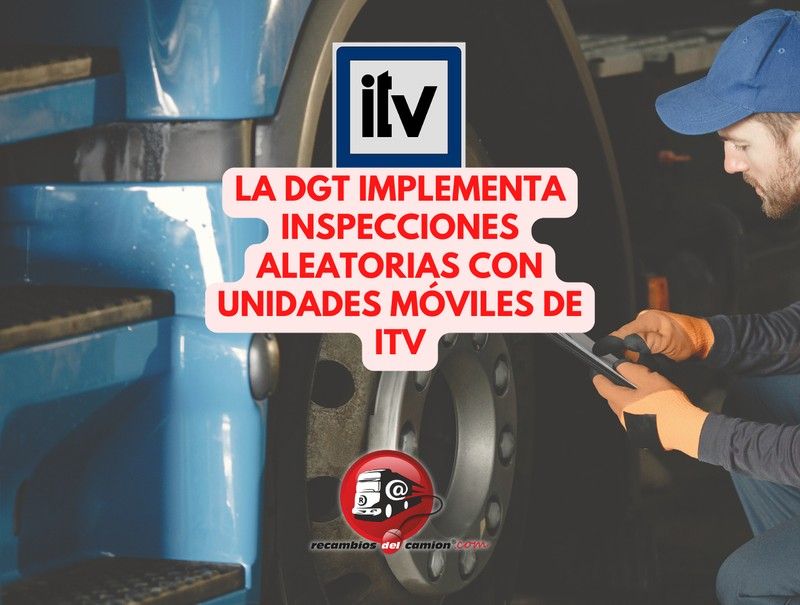The DGT implements random inspections with mobile ITV units
In recent months, the Directorate General of Traffic (DGT) has implemented a new strategy to ensure road safety in Spain. These include random, unannounced inspections of vehicles on the road to detect mechanical or safety faults that could endanger drivers and other road users. These inspections, which include the use of new mobile vehicle inspection stations (ITVs), are being carried out more frequently and aim to detect problems before they reach the conventional vehicle inspection station (ITV).

Random inspections carried out by the DGT are technical checks carried out without prior notice to drivers, at strategic locations along the roads. This measure seeks to increase the effectiveness of the checks by not allowing drivers to prepare for the control. In these types of inspections, traffic officers check technical aspects of the vehicle, such as brakes, lighting, emissions, and tire condition, among others.
Unlike traditional ITV (Technical Inspection of Vehicles), which are carried out at fixed stations and by appointment, random inspections are more mobile and are carried out anywhere on the road network. Vehicles are stopped at points where officers consider the check can be carried out without interrupting traffic flow. To this end, mobile ITV units equipped with advanced technology are used to carry out these checks quickly and efficiently.
The main objective of random inspections is to increase road safety and reduce the number of accidents caused by vehicles in poor condition. According to authorities, many traffic accidents occur due to mechanical failures that could have been avoided if the vehicle had been inspected in a timely manner. In fact, the DGT (Directorate-General for Traffic) has indicated that these checks are one of the most effective measures to prevent accidents and deaths on the road.
This type of inspection also allows irregularities in vehicles to be detected before they reach the conventional MOT (Inspection of Vehicles), where they could go unnoticed. It also helps to identify vehicles that are circulating without having passed the MOT (Inspection of Vehicles) or that do not meet the technical requirements necessary to be on the road.
One of the most notable innovations of this strategy is the mobile MOT (Technical Inspection Service). These units are equipped with the necessary technology to perform inspections efficiently, quickly, and safely. These mobile MOT units are designed to be deployed at strategic points along the road network, allowing traffic officers to carry out checks without having to divert drivers to fixed stations.
Furthermore, mobile MOTs allow for much faster inspections than conventional ones. In many cases, vehicles can be inspected in a matter of minutes, significantly reducing waiting time and inconvenience for drivers. This type of MOT also allows for a more thorough inspection, as vehicles are inspected in real-life driving situations.
Drivers should be prepared for the possibility of roadside inspections at any time. Inspections are random, so there is no way to predict when and where they will take place. It is critical that drivers keep their vehicles in good condition and comply with all safety regulations, such as maintaining brakes, lights, tires, and emission systems, to avoid surprises and fines during inspections.
Additionally, it is important to remember that if serious vehicle defects are detected, the driver may be penalized and required to repair the vehicle immediately. In some cases, if the vehicle is deemed unsafe, the driver may be required to take it off the road until it is repaired.
During these inspections, traffic officers have the ability to check several technical aspects of the vehicle, including:
- Brakes: Checking that the braking system is working properly.
- Lights: Checking that all lights and signals on the vehicle are operational.
- Tires: Checking the condition of the tires, including pressure and wear.
- Emissions: Checking the vehicle's pollutant emission levels.
- Steering system: Checking that the steering system is working properly.
- Documentation: Checking that the MOT is up to date and that the vehicle has the necessary documentation.
If a vehicle fails a roadside inspection, traffic officers may issue a fine and, in some cases, require the vehicle to be repaired before it is allowed to drive again. If the faults are serious, drivers may be fined or, in the worst case, banned from driving until the problems are fixed.





Opinions of our clients
Receive our news